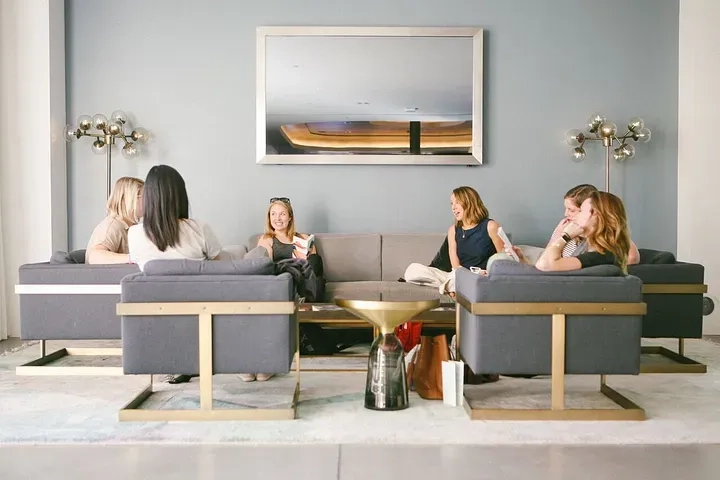Within Retreat learnings: The importance of diversity and mindfulness in leadership
Five ways emerging women leaders can lift each other up

Within, a retreat for emerging women design leaders in tech, is an immersive four-day experience. It provides an intimate space to connect and exchange ideas, discover new methodologies and strategies, and practice mindful leadership.
Microsoft was one of the event sponsors this year, and six women from our company attended the fall retreat in Paradise Valley, AZ. Through workshops, discussions, coaching circles, creative activities, and time spent building a community with other women, we developed a strong bond with each other and learned a great deal about ourselves.
It was an incredible opportunity for growth and development, and we wanted to share our top five takeaways.
1. Amplify stories of more diverse leaders.
Part of Within’s mission is to “amplify stories of more diverse leaders — not just in gender and race, but also style.” Witnessing a range of leadership styles through nightly discussions was a particularly valuable part of the retreat.
During these candid Q&As, leaders at Facebook, Google, Shopify, Dropbox, and other organizations shared stories about enabling creativity on their teams and fueling their own best work through self-care. They offered insights on the importance of seeing and nurturing potential, the value of transparency, and setting boundaries to safeguard work-life balance.
Each night we had a different “aha” moment as we saw how each of these women had channeled their authentic selves into creating successful business outcomes. We left these talks with a clearer understanding that leadership is not about conforming to a mold but finding ways to elevate your team and your work through your unique capabilities.

2. Elevate your team.
It’s easy to get sucked into drama at work. Who’s slacking, who’s upset, what “dumb” decision someone made today. These conversations happen daily, and leaders rise not by fueling the fire but by rolling up their sleeves.
During fireside chats, we discussed the idea of leadership as teamwork. As a leader, you’re responsible for getting your hands dirty and helping others do their best. When faced with challenging dynamics or stressful situations, leaders don’t run away. Leaders meet people where they are and raise them to where they need to be. Paraphrasing Michelle Obama, when they go low, you take them high.
There’s likely a very good reason for that “dumb” decision. Or a very human explanation for the sub-par performance. Do we look for opportunities to point fingers or to lend a helping hand? When we assume the best in others, we show them how to do the same. That’s a team we want to be on. Luckily, it’s also one we can help create.

3. Don’t just solve problems — empower yourself and others.
As designers and leaders, we often fall into the role of rapidly identifying and solving problems. But that means sometimes we can leap to solutions too quickly! As leaders, it’s essential to not just fix challenges for those around us but to help guide them through their own processes for tackling challenges.
Throughout the week, we each shared a problem or challenge we were facing. Instead of responding simply with advice, we practiced asking deep questions and reflecting what we heard to help the person sharing explore their own thoughts and come to their own conclusions. Getting new viewpoints from peers was helpful and often led to new perspectives and unexpected solutions.

4. Decouple from your inner critic and leverage your inner ally.
We also practiced resilience against our inner critic, the voice inside our heads that drags us down. We identified what our inner critic says to us daily — when we look in the mirror, have a big idea, or are in a room of people more senior than we are. It was an emotional exercise to go through!
We personified our inner critics, giving them a name and a list of character traits. Then, we did the same thing for our inner ally, the voice inside our heads that lifts us up and makes us resilient and brave.
Next, we went through a series of questions about a specific risk that we wanted to take and answered from the perspective and voice of our inner critic. We did the same exercise again but had our inner ally respond to our inner critic.
Personifying our inner critic and separating them from ourselves was an immensely helpful strategy. It created a distance and helped us realize that, if someone in our life was talking to us with that negativity, we would never tolerate it. So why should we tolerate it from our inner critic? Responding to our inner critic with our inner ally was a good way to regain perspective, confidence, and self-compassion.

5. Build a solid network.
One of the most valuable and memorable aspects of Within was the group of outstanding women who attended. It was surprisingly easy for even the most introverted women to share their experiences as women in design leadership. We coached one another and gave each other ideas for ways to tackle our day-to-day challenges and grow into the leaders we all aspire to be.
As women in the tech industry, it can be difficult to find role models we relate to and who show us that women leaders can get those coveted C-suite positions. By bringing in women who are VPs of design to not only speak to the group but participate as attendees, Within showed us what is possible for us as design leaders. Hearing how some of the most successful design leaders have also struggled with self-confidence and their own inner critic was both validating and empowering.

We left Within not only with our learnings from one another but also with an amazing network of women leaders we will continue to reach out to even after leaving Paradise Valley. As emerging leaders, having honest conversations and building meaningful relationships helps us become more resilient and trusting of our abilities.
Read more
To stay in the know with Microsoft Design, follow us on Twitter and Instagram, or join our Windows or Office Insider program. And if you are interested in working with us at Microsoft, head over to aka.ms/DesignCareers.

Centering Sign Language in AI and design
A Deaf-led approach to making Sign Language a core principle of inclusive design

Prioritizing inclusion over convention: Rethinking how we design packaging
The Microsoft Packaging & Content team just released “Creating Accessible Packaging: An Inclusive Design Guide,” available for all.

